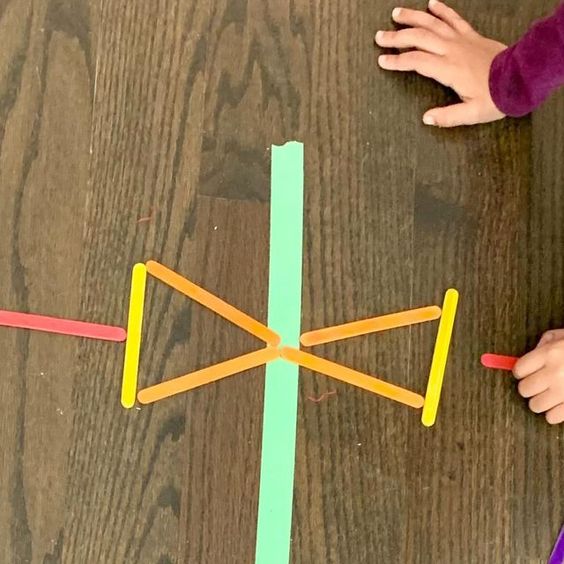Popsicle sticks
Tape (preferably colorful or easily visible)
Flat surface for arranging the popsicle sticks
Introduction:
Explain the concept of reflection symmetry. Show examples of symmetrical objects and patterns.
Demonstrate how one side of a symmetrical object is a mirror image of the other side.
Setting Up:
Lay a piece of tape down the center of a flat surface (table, floor, etc.). This tape line will act as the line of symmetry.
Arrange a few popsicle sticks on one side of the tape in a simple pattern.
Demonstration:
Show the children how to create a reflection of the popsicle sticks pattern on the other side of the tape.
Emphasize that each stick should be placed exactly opposite to the one on the other side to create a mirror image.
Hands-On Practice:
Allow each child to set up their own pattern of popsicle sticks on one side of the tape.
Have them create the reflection on the other side of the tape.
Peer Interaction:
Once they are comfortable with the activity, have the children set up patterns for each other to reflect.
Encourage them to take turns arranging and reflecting the popsicle sticks.
Support and Guidance:
Provide assistance to children who may find it challenging to understand or create the symmetrical pattern.
Use verbal cues and physical demonstrations to guide them through the process.
Reflection and Discussion:
Ask the children to share their symmetrical designs and explain how they created the reflection.
Discuss the importance of symmetry in everyday life and in nature.
Additional Challenge:
Introduce more complex patterns and shapes using the popsicle sticks.
Challenge the children to create symmetrical designs without a pre-set pattern from you, encouraging creativity and independent thinking.
Difficulty Levels:
Kindergarten: Focus on simple and fewer popsicle sticks. Provide more guidance and support.
Grade 1: Introduce slightly more complex patterns and encourage independent exploration.
Grade 2: Challenge children with intricate patterns and minimal guidance.
What Happened?
Children created symmetrical designs using popsicle sticks and tape, practicing reflection symmetry.
They developed fine motor skills and spatial awareness through hands-on manipulation.
The activity provided a fun and interactive way to understand and apply symmetry concepts.
Explore More:
Use other objects like colored blocks or beads to create symmetrical designs.
Integrate symmetry activities into art projects, such as symmetrical drawings or paintings.
Explore symmetry in nature by observing symmetrical patterns in leaves, flowers, and animals.
Extension Activities:
Create asymmetrical designs and discuss the differences between symmetry and asymmetry.
Use mirrors to explore reflective symmetry with 3-D objects and observe how reflections create symmetrical patterns.
Incorporate symmetry into building activities, challenging children to create symmetrical structures using building blocks or LEGO.

